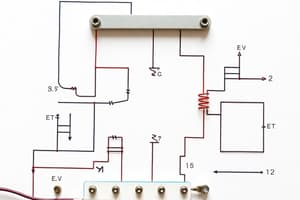Podcast
Questions and Answers
What is the primary function of a power gate in an electrical system?
What is the primary function of a power gate in an electrical system?
- To convert alternating current (AC) to direct current (DC)
- To control the flow of electricity by opening and closing a circuit (correct)
- To increase the voltage of an electrical signal
- To reduce the resistance in a circuit
Which of the following is NOT a typical component found in a power gate?
Which of the following is NOT a typical component found in a power gate?
- Capacitor (correct)
- Contacts
- Trip mechanism
- Coil
What is the main difference between a fuse and a circuit breaker?
What is the main difference between a fuse and a circuit breaker?
- Fuses are reusable, while circuit breakers are not.
- Circuit breakers operate faster than fuses.
- Fuses are designed to handle higher currents than circuit breakers.
- Circuit breakers are reusable, while fuses are not. (correct)
What is the purpose of the trip mechanism in a power gate?
What is the purpose of the trip mechanism in a power gate?
Why is it important to select the correct amperage rating for a power gate?
Why is it important to select the correct amperage rating for a power gate?
Flashcards
Electricity
Electricity
A form of energy resulting from the existence of charged particles.
Circuit
Circuit
A complete path through which electric current can flow.
Voltage
Voltage
The electrical force that drives an electric current between two points.
Current
Current
Signup and view all the flashcards
Power
Power
Signup and view all the flashcards
Study Notes
Basic Electrical Theory
- Direct Current (DC) flows in one direction.
- Alternating Current (AC) reverses direction periodically.
- Voltage is the electrical pressure that drives current.
- Current is the flow of electrons.
- Resistance opposes the flow of current.
- Ohm's Law: Voltage = Current x Resistance (V = IR).
- Power (Watts) = Voltage x Current (P = VI).
- Series circuits: Components are connected end-to-end. Current is the same through all components, voltage is divided.
- Parallel circuits: Components are connected across each other. Voltage is the same across all components, current divides.
Types of Electrical Circuits
- Series Circuits:
- Components connected linearly.
- Current is the same throughout the circuit.
- Total resistance is the sum of individual resistances.
- Voltage drop across each component is proportional to its resistance.
- Parallel Circuits:
- Components connected across each other.
- Voltage is the same across all components.
- Total conductance (reciprocal of resistance) is the sum of individual conductances.
- Current divides among branches, inversely proportional to their resistances.
AC Circuits
- AC circuits involve sinusoidal voltage and current.
- Frequency is the number of cycles per second (Hz).
- Impedance is the opposition to AC current flow, encompassing resistance, inductance, and capacitance.
- Inductance opposes changes in current flow.
- Capacitance stores energy in an electric field.
- Resonance occurs when the inductive reactance and capacitive reactance cancel each other out often in AC circuits, resulting in a low impedance, therefore high current.
Electrical Safety
- Always follow safety procedures, especially when working with electricity.
- Use appropriate personal protective equipment (PPE).
- Grounding is crucial for safety, preventing accidental shocks.
- Never work on live wires unless necessary and authorized.
- Disconnect power before working on any electrical system.
- Be aware of potential hazards like frayed wires, exposed connections, and overloaded circuits.
Power Gates & Control Systems
- Power gates regulate the flow of electricity to equipment.
- They often contain circuit breakers, fuses, and other protective devices.
- Control systems automate operations through sensors, relays, and other electronic components.
- PLC (Programmable Logic Controllers) are used for complex automation tasks.
- SCADA (Supervisory Control and Data Acquisition) systems monitor and control large-scale systems.
- Safety interlocks ensures equipment is not operated in unsafe conditions.
- Gate actuators are often electrically controlled and provide precise movements for gates
Important Electrical Concepts
- Conductors allow electric current to flow easily.
- Insulators resist the flow of current.
- Semiconductors have properties between conductors and insulators.
- Kirchhoff's laws govern the behavior of complex electric circuits.
Troubleshooting
- Common electrical problems include tripped circuit breakers, flickering lights, and malfunctioning appliances.
- Identifying the cause of a problem involves systematically checking components and connections.
- Accurate voltage, current and resistance measurements are essential tools in troubleshooting.
Types of Electrical Equipment
- Circuit breakers, fuses, transformers
- Motors, generators
- Lighting devices
- Switches
- Relays
Studying That Suits You
Use AI to generate personalized quizzes and flashcards to suit your learning preferences.




